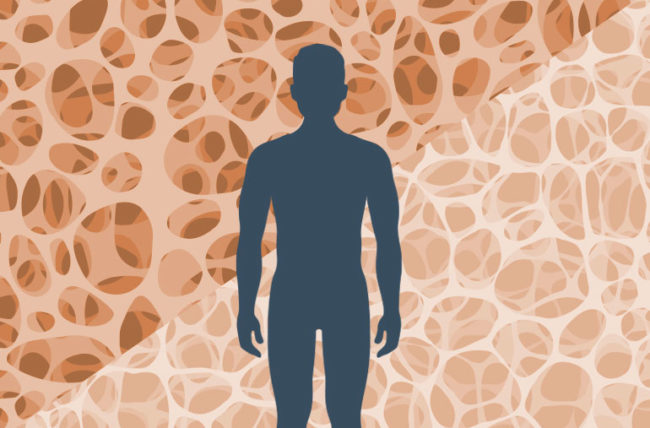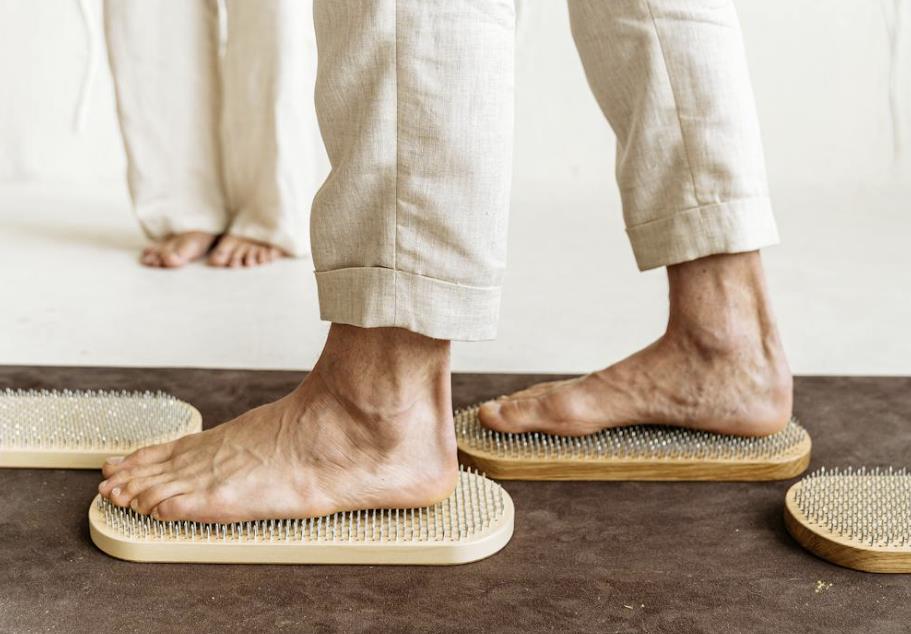Define Osteoporosis
Drink your milk! Remember how your parents used to hound you? No doubt they knew that mile helps build strong bones- better than just about any food. And building strong bones when you’re young is one of the best ways of preventing osteoporosis later in life.
In Latin, the term osteoporosis literally means “porous bones.” And that’s a pretty accurate description of this condition. Look through a microscope at a healthy person’s bones; they’ll appear as a near-solid mass. But look at the magnified bones of someone with advanced osteoporosis, and you’ll see something about as porous as a fishnet.
Osteoporosis is a common condition, affecting more than 24 million Americans, according to U.S. government figures. Four out of five of those who have this condition are women. The Duke University Medical Center in Durham, North Carolina, estimates that if you’re a woman older than 50, your risk of developing osteoporosis is greater than your combined risk of developing breast, ovarian, or uterine cancer.
Bone Basics
Osteoporosis isn’t caused by a virus. And it’s not a genetic disease. This is a condition brought on by a variety of factors, many of them having to do with diet. In the years following menopause, women can lose up to a quarter of their bone mass.
People born with thin bones also face a heightened risk; for the simple (if unfair) reason that they have less bone mass, to begin with. Another major culprit: lack of exercise. When you jog, mow the lawn, or ride a bike, your bones-just like you’re muscles-literally grow stronger.
Spend all your time slumped before a computer or TV, and the opposite happens. Long-term use of steroid drugs such as prednisone can likewise increase your risk. But people who fail to eat a proper diet face the greatest risk of all; experts say this brings us back to milk.
Like other dairy products, milk is rich in calcium, the stuff that makes up your very bones. Calcium, the same mineral found in blackboard chalk, causes bones to be solid and hard. Take away the calcium, and humans would turn into land-roving jellyfish-no bones about it.
Bones constantly need calcium to patch and repair themselves and to replace old dead cells with new ones. Elsewhere in the body, calcium performs other vital tasks: It aids in blood clotting, helps nerves function smoothly, and it assists the heart and every other muscle.
Little wonder calcium is the most common mineral in your body. Fortunately, it’s also plentiful in many of the foods we eat. Chalk one up to Mother Nature. “Calcium’s pretty cheap. You ought to be able to get enough of it,” says Dr. C.
Conrad Johnston Jr., M.D., an osteoporosis researcher at Indiana University School of Medicine in Indianapolis. Just one glass of whole milk contains roughly 300 milligrams of calcium. Cheese, yogurt, and other dairy products are also calcium-rich. And you find the mineral in vegetables, soy foods, and even bread.
The beauty about bread is that you eat quite a few servings of them,” says Mona Calvo, Ph.D., a nutritionist with the Food and Drug Administration (FDA), who specializes in osteoporosis. Dr. Calvo starts counting off all the familiar bread group foods that form staples of the American diet-everything from pasta and hamburger rolls to crackers and tortillas. All of these contain some calcium and help boost your daily intake. “It all adds up,” she says.
Investing in Precious Minerals
When you eat calcium-rich foods, it’s like putting money in the bank. That’s because your bones-besides providing a framework that defines your basic shape and holds you together-function as a kind of calcium bank vault.
Say your body needs a little extra calcium to keep your heart muscle running at a brisk clip during your morning walk. Or let’s say your muscles have a lot of mending to do after the day you try in-line skating for the first time. No problem. Your bone bank stays open 24 hours a day.
And your body can go in there and take whatever extra calcium it needs to get the job done. Hopefully, any calcium your body withdraws from your bones today will be replaced with calcium contained in the foods you eat tomorrow. But suppose you’re a picky eater?
Day after day, month after month, you fail to replace the calcium that your body withdraws. That’s a lot like draining a savings account. Your body keeps making withdrawals that aren’t replaced. Your bones grow weaker and weaker. It’s that simple.
Well, it’s almost that simple. A couple of other factors come into play as well. As you age, your body grows less and less able to process the calcium you eat. After about age 30, your bones actually lose a tiny percentage (about .03 to .05 percent) of their mass each year.
With women, this bone loss greatly accelerates after they’ve gone through menopause, around age 50. That’s because following menopause women produce far less of the hormone estrogen. And estrogen, when it’s present, helps the body channel calcium efficiently to the bones. In males, the hormone testosterone performs a similar function.
In the years during and after menopause, a woman can lose up to 10 percent of the hardened shell portion of her bones (so-called cortical bone) and as much as 25 percent of the softer (trabecular) bone contained inside After 10 years, bone loss continues at about 1 percent each year.
The same rate Occurs in men once they’ve reached their mid-60s As you age, you don’t feel this bone loss. It takes place silently, painlessly. You may not even know it’s happening without a doctor’s exam X-rays, the most common way of detecting osteoporosis, only reveal the disease when bones have deteriorated by up to 30 percent.
Weakened bones break easily, and some people find out that they have osteoporosis only after breaking a bone. Some people who have advanced osteoporosis have bones so weak that the slightest bump causes a break. Unfortunately, this advanced stage, complete with fragile, easily broken bones, happens a lot.
According to the FDA, 1.5 million osteoporosis-related fractures occur annually. Complications from these bone fractures can cripple and even lead to death. As osteoporosis progresses, women, in particular, can develop what’s known as a dowager’s hump. That’s a curvature of the spine caused when individual vertebrae, weakened by osteoporosis, are literally crushed. The best strategy for dealing with this crippling disease is prevention. And the good news is that you can do a great deal early on to keep osteoporosis at bay.
Eat Right from the Get-Go
The very best way of fending off osteoporosis is to eat right as a youngster. That brings us back to milk once again. “It’s very important that you have an adequate amount of calcium as you’re growing,” says Dr. Johnston. No surprise, kids with rapidly growing bones need plenty of calcium.
But Dr. Johnston goes a step further. He says the more calcium kids take in as they’re growing, the better. An extra measure of calcium at this crucial time helps them build extra-strong bones that will offer them a measure of protection later in life.
In the late ’80s, Dr. Johnston set out to prove his theory with a simple experiment. He looked at identical twins. For each set of twins participating in the study, one twin (the control subject) ate a regular healthy diet. The other twin (the test subject) at the same healthy diet, but also received a calcium supplement.
Dr. Johnson used a supplement so he could precisely measure the amount of calcium his test subjects received. (Although calcium supplements are not harmful, Dr. Johnston recommends that kids get the calcium they need through regular foods, not supplements.)
After three years, Dr. Johnston found that those twins that received the extra calcium had developed a measurably heavier bone structure. They’d taken that extra calcium and stored it in their bones. Think back to the bone bank analogy.
All that calcium stored up within young bones is really a kind of investment for later in life-a time when menopause and plain old age cause bones to lose density. The more calcium deposited in the bone bank early on, the more will be available for withdrawal later.
Building Strong Bones
Just how much calcium should kids receive? Most experts put the amount between 400 and 1,200 milligrams, on age depending. A typical kid’s diet can easily supply chat 1,200 milligrams. How? Cereal with milk for breakfast, some cheese on that sandwich at lunch, a couple of glasses of milk, ice cream, or yogurt at some point during the day and you have it.
Two of the U.S. government’s most important health organizations support the 400- to 1,200-milligram recommendation: The FDA and the National Institutes of Health (NIH). But you should be aware that the FDA and the NIH don’t always see eye to eye about how much calcium people need.
Prime example: recommendations for the 11-to 24-year-old age group. This is a crucial time in terms of bone-building. First, kids enter adolescence and typically sprout up by awkward leaps and bounds, their bones growing apace. Then, during their late teens and early adult years, they reach their full height.
Young people don’t grow as much in their late teens and early twenties, but their bones do continue to harden. The NIH considers this bone-building-and-hardening period crucial for protecting people from osteoporosis later. After all, you get one chance to build a skeleton.
That’s why the NIH recommends that those in the 11-to-24-year-old group receive 1,500 milligrams of calcium per day. This is the exact same dosage the NIH recommends for older folks, who may have already developed osteoporosis.
The FDA continues to recommend 1,200 milligrams of calcium daily for 11- to 24- year-olds. That puts the two groups just a 300-milligram glass of milk apart. Whose recommendations should you follow? If you’re fighting osteoporosis, or concerned about preventing osteoporosis, you should be aware that powerful groups like the National Osteoporosis Foundation, the Mayo Clinic, and the Duke University Medical Center stand behind the higher NIH estimates.
And we’ll stick with these same recommendations through the remainder of this section. The NIH maintains that a calcium intake of up to 2,000 milligrams a day is safe. Exceed 2,000 milligrams per day, however, and over the long haul, you may risk such things as painful calcium deposits and kidney stones. These occur when your system stores more calcium than it can use.
Hooked on Pop
Rather than being concerned about getting too much calcium, say Drs. Johnston and Calvo, the majority of us need to be far more concerned about getting enough.
This is a special concern when it comes to children. The Duke University Medical Center estimates that one-third of children younger than age five only receive about 75 percent of the recommended daily calcium they need. That tendency to get too little calcium continues as kids age, explains Dr. Calvo.

Read More – Constipation – A Preventable Condition
Product You May be Interested
- Feel Emotional Freedom! Release Stress, Heal Your Heart, Master Your Mind
- 28-Day Keto Challenge
- Get Your Customs Keto Diet Plan
- A fascinating approach to wipe out anxiety disorders and cure in just weeks, to become Anxiety free, relaxed, and happy.
- Flavor Pairing Ritual Supercharges Women’s Metabolisms
- The best Keto Diet Program
- Boost Your Energy, Immune System, Sexual Function, Strength & Athletic Performance
- Find Luxury & Designer Goods, Handbags & Clothes at or Below Wholesale
- Unlock your Hip Flexors, Gives you More Strength, Better Health, and All-Day Energy.
- Cat Spraying No More – How to Stop Your Cat from Peeing Outside the Litter Box – Permanently.
- Anti-aging nutritional unexplained weight gain, stubborn belly fat, and metabolic slowdown. Reach Your Desired Weight in a Week and Stay There.
- Get All Your Healthy Superfoods In One Drink






